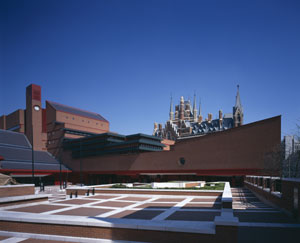Sir Colin St. John Wilson, RIBA, a noted British architect, educator, and arts patron, died on May 14, at the age of 85. Known as “Sandy” to his friends and colleagues, he had taught at both Yale and MIT, and served as director of the Cambridge School of Architecture. Wilson’s enduring built achievement is the British Library. Completed in 1997, this controversial but now celebrated landmark adjacent to St. Pancras Station, London, was a commission that occupied several decades of his career. The red brick, asymmetrically formed building represents the culmination of his approaches, combining monumental scale with great attention to detail.

Sir Colin St John Wilson's British Library, completed in 1997.
Image: © Richard Bryant/Arcaid
Kenneth Frampton, a professor at the Columbia University Graduate School of Architecture and Planning, notes that Wilson was a member of a “distinguished generation” of Modern architects who were trained during the 1930s and then had a chance to express their theories as Britain rebuilt after the Second World War.
“Wilson was a vital spirit on the British architectural scene and as the years unfolded. He made his name not only as an architect with Leslie Martin and Patrick Hogkinson, but also as a distinguished teacher,” Frampton says. “Despite his affinity for Europe—for the methods and materials of Alvar Aalto, for example—Sandy was decidedly influenced by Louis Kahn in his early domestic work, however much this was mediated by the British Brutalist brick aesthetic of the late 1950s.”
Frampton continues, “A key aspect of Sandy’s later life and career was his strong feeling and advocacy for what he called The Other Tradition: namely for the more organic wing of the German Modern movement in the 1920s and 1930s—above all for Hans Scharoun and Hugo Haring—as well for Scandinavian and Nordic Modernism, in particular unique appreciations of Erik Gunnar Asplund, Sigurd Lewerentz, and Aalto.”
For Wilson, these architects provided deep, necessary sources of strength and inspiration for architecture—especially amidst the unprincipled historicism and obtuse theorizing of the 1980s and 1990s. As he wrote in 1981, “When I recall Asplund’s reference to ‘forms which do not frighten but invite,’ I am filled with conviction that there is a whole world of imagination to be explored in the service of an architecture that does not compress all responses into a hushed submission, but opens up and enlarges that experience beyond all expectation.”
Wilson was an avid collector of modern British art. He served as a trustee of the Tate Gallery and of the National Gallery. His own collection included works by Paolozzi, Kitaj, Richard Hamilton, and Peter Blake. Now housed at the Pallant House Gallery, in Chichester, it has been hailed as one of the best British 20th century collections in the country. Wilson is survived by his wife, the architect and educator M.J. Long, daughter, Sara, and son, Harry.


Post a comment to this article
Report Abusive Comment